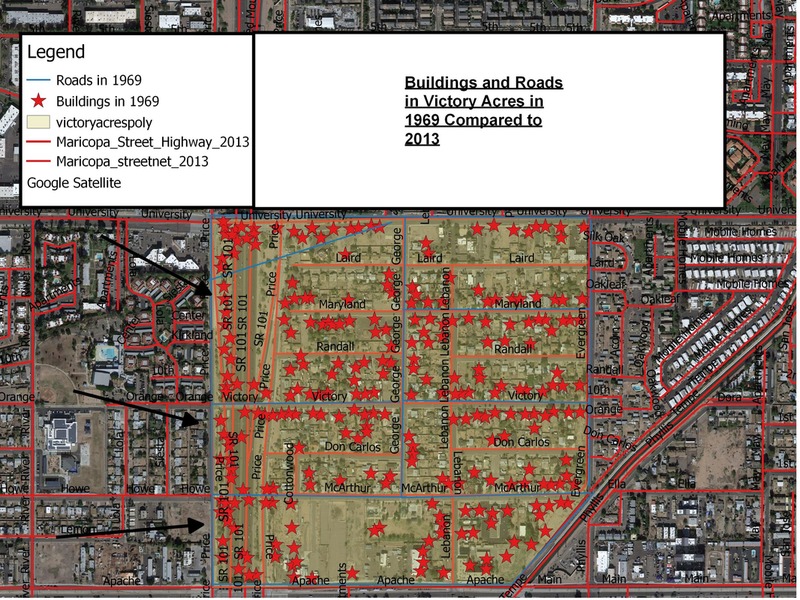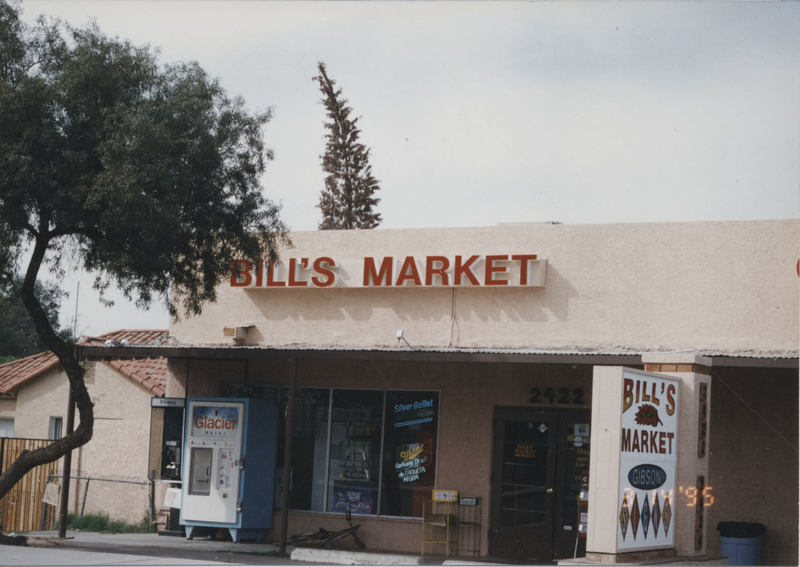
Permalink Creator: Designed by Brooks Waybright Date: August 7, 2016
The Victory Acres neighborhood of Tempe highlights the unique story of Mexican-American suburbanization.
The Victory Acres neighborhood of Tempe highlights the unique story of Mexican-American suburbanization. La Victoria, a tight-knit, predominantly Mexican American, community, emerged during the post-War growth of Tempe and the surrounding region. La Victoria is the story of the perseverance of Mexican Americans in the face of discrimination. The community also survived a highway being built next to it and its partial destruction. The families in this neighborhood played a vital role as the area underwent a change from “rural farmland to urban landscape.”
In 1945, following World War II, local farmers George and Mary Tishbraney decided to partition their eighty acres of farmland into individual plots and sell them to others. They named it “Victory” Acres because the term had become popular in the war effort. Over time, the neighborhood grew to become a mostly Mexican American neighborhood, or barrio. Many of the first families that moved to Victory Acres came after their homes in the old San Pablo neighborhood were destroyed so that the university could expand. But despite their challenges, the people are close and lifelong members of the community remember feeling safe and at home among their neighbors and friends. “Many long-time residents and their families continue to reside here. They are proud of their community and are surrounded by strong ties of memory and friendship.”
Victory Acres was the home of many World War II veterans and their families. The legacy of service to their country continued, and many who lived in Victory Acres went on to serve in the Vietnam War before returning back home to their neighborhood in Tempe. Many veterans, like Carlos Labastida who served in Vietnam, described how their memories of Victory Acres helped them get through the difficulties of the war. He said, “My memories would always come back to the Acres. I swore that if I ever came back alive that I would always walk the streets again. I would remember the Acres so fondly.” David Johnson, the owner of Watson’s Flower Shop in Victory Acres remembered Memorial Day as being one of the busiest days of the year for his family’s business. He described, “On Memorial Day here at the flower shop it would get very busy. Everybody from Victory Acres would come over and buy flowers for their departed relatives or for deceased fathers who had previously served in the military. We would spend all morning selling flowers.” This common characteristic of many of these families having military ties contributed to the deeper community connection.
Places such as Bill’s Market, formerly known as Kalil’s Market, are remembered by many as significant community gathering places. Bill’s Market is especially remembered for the kindness of its owner Mary Tishbraney. This store “provided more than a place to buy groceries,” because “the market owners gave poor residents credit, delivered groceries, sponsored local youth sports teams, and even lent money to people in need.” Other prominent places like St. Margarita’s Church, Tempe Beach, and other sites provided gathering places for the children and community as well. These and many other places served to help establish the very close and interconnected community that Victory Acres is known to be.
Over the years, Tempe became more and more developed. Victory Acres remained where it was while other small neighborhoods were lost in the modernization and redevelopment. The freeway was built right next to Victory Acres, destroying several of the houses, yet the community remained. More recently, the light rail was extended and now passes by Victory Acres as well, but again, the neighborhood stayed where it was. Victory Acres does not have the typical modern development story like the rest of Tempe. It was largely ignored for decades. Not until the mid-1980s did this neighborhood first receive street lighting and paved roads. Because the freeway somewhat isolated Victory Acres from the rest of Tempe, and also because it was a predominantly Mexican American neighborhood, it was not given priority in redevelopment projects and was often the last to receive improvements. Some residents, though they love Victory Acres and have no plans of leaving, expressed some anxieties for their children. They worry about the heavy traffic of the freeway and Price Road being so close, and about a lack of city and recreational facilities for their children’s use. So, although it has come a long way, Victory Acres is still waiting for further city development in certain areas of need.
Although it was not given priority for redevelopments, and much needed improvements took a long time to come to Victory Acres, residents are still grateful that the neighborhood has remained through it all. One man, Elias Esquer, who grew up and still resides in Victory Acres discussed the vitality of the community. “It’s a good model on how to develop a community without destroying it-without having to go in and buy everybody out and sell it to developers which is happening in a lot of cities, it destroys the culture of the neighborhood. La Victoria remains a very stable Hispanic community.” Victory Acres is unique in its resilience to last through the redevelopment of Tempe.
Victory Acres sprang up at the end of World War II and really developed into the neighborhood it is today during the post-war years. Following World War II, the housing economy was booming and there are many trends that are common to see in neighborhoods built in this time. Big companies came in and built houses quickly and so they were very similar in their architecture. Victory Acres houses share some similarities, such as a majority of them being single story and single family homes built by the individuals and families who bought the land. However, there is one significant way in which the Victory Acres neighborhood fit in with the general trend of the post-war suburbs, and that was in its “economic and racial homogeneity.” Many Mexican American families were relocated to Victory Acres when the San Pablo neighborhood was demolished to build up the university in Tempe. Although Victory Acres didn’t start out as a segregated neighborhood, it quickly became predominantly Mexican American and has largely remained that way throughout the years.
Victory Acres is an example of a neighborhood that became a close community and one that tells a unique story of redevelopment in Tempe. Whether through military service or through associations at local gathering places, through struggles and redevelopment, Victory Acres has grown over the years and remains a tight-knit community today.
Images

Permalink Creator: Designed by Brooks Waybright Date: August 7, 2016

Permalink
Creator: City of Tempe Community Development Department Date: May 18, 1973

Permalink Creator: City of Tempe Community Development Department Date: Circa 1980

Permalink Creator: City of Tempe Community Development Department Date: March 14, 1995

Permalink Creator: City of Tempe Community Development Department Date: May 18, 1973

Permalink Creator: City of Tempe Development Services Department Date: September 4, 2001


Permalink Date: July 28, 1982
